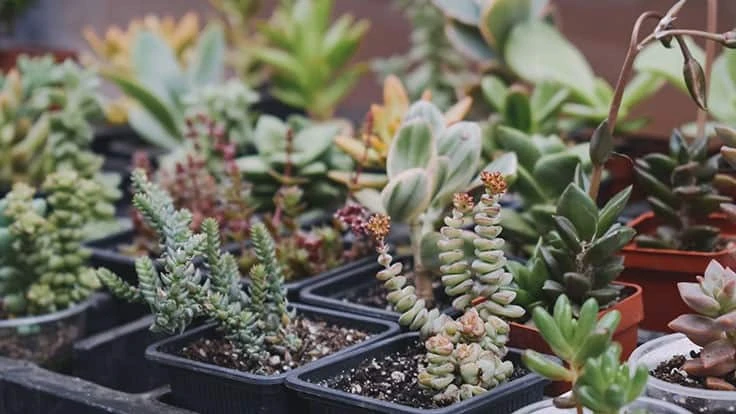
Adobe Stock

Succulents — those tiny, weird cacti-looking plants that are becoming more and more ubiquitous at IGCs and big-box retailers — were big sellers during the 1970s and 1980s, and, like most consumer trends, they’ve come full circle, roaring back to popularity of late.
Millennials — and social media — are the main drivers of the succulent renaissance, says Dave Holley, general manager at Moss Greenhouses, a wholesale plant distributor in Jerome, Idaho. Holley hosted a presentation on succulents at AmericanHort’s inaugural Finished Plant Conference last fall.
“By 2027, succulents will be an $8 billion in revenue annual business segment,” he shares, adding that Moss started growing succulents with 200 flats back in 2012. Today, the business says that they’re averaging 5,000 flats of succulents annually.
One key in putting together a successful succulents program is to be good at forecasting and planning, because the unrooted cuttings (URCs) that you’ll need to start production are typically in shorter supply than traditional ornamental cuttings.
“You’ve got to be able to forecast out 12, 16, even 20 weeks in advance if you’re looking to get good availability of a lot of different varieties,” Holley explains. “If you go on [a young plant grower’s] site today and want to order plants for a month or two from now, you’re probably not going to see a good selection to choose from. Get those orders in early.”
Another option is to grow non-patented varieties, which Holley says you can then take “pups” or cuttings from that can be rooted into viable young plants. If you choose varieties that are under patent, then you’ll have to ask the propagator about any royalty fees you’d be responsible for.
“[That’s] just one more thing that can help keep your costs down, which is key for this crop as well,” Holley adds.
Some key revelations about succulent production that Holley shared:
Having a wide variety availableto your customers is key, he says. “You won’t be successful if you’re offering just one or two varieties, you’ve got to have more to round out that program.”

Currently, Dümmen Orange is the main supplier of URCs of succulents to commercial growing operations. And they include a color tag with each flat of URCs, which is valuable for growers that don’t have time to create custom tags. Moss has also sourced from Quality Cuttings in the past.
On the subject of which soil mixes are best, Holley says that succulents like a sandy-loam soil. But since most growers don’t have ready access to enough sand to mix into their custom-blended mixes, he recommends SunGro’s #4 mix with some added perlite to help with drainage and to mimic naturally sandy soil. Berger’s #5 mix is another option they’ve found workable with succulents.
Sunlight is your friendas a succulent grower, he says. The plants thrive in hot, sunny, and humid conditions in the greenhouse, and the best vegetative growth will occur when they are grown on raised benches.
Water sparingly,because succulents do not require a lot of water. “A good rule of thumb is to let them dry down completely before watering, even up until they start to show some wilting. And watering in the morning is best so that the medium has plenty of time to drain and dry down before nighttime. Implement a weekly flush with clear water as well to keep salt buildup down.
Some people will tell you that you can only grow succulents in the spring,but Holley says a recent study from Cornell University has disproved that theory. “You can grow them anytime of year where you have enough light,” he says. “I was initially surprised at the sales we saw during winter, and they really tie in nicely with our tropicals program.”
Keep the growing medium pH between 5.7-6.3,and electroconductivity (EC) readings in the .75-.80 range. Usually, a fungicide application within 24 hours of sticking is effective at maintaining plant health. Fertilize succulents regularly, as doing so helps draw out more vivid colors.
One of the best parts of growing succulents in the greenhouse is that, in general, they are a low pest pressure crop, he says. But keep an eye out for mealybugs between the leaf and the stem, and scale are another pest that will attack succulents if given the opportunity. A broad-spectrum insecticide is usually effective in controlling both of those pests. Aphids and spider mites can also become problematic, and Holley suggests using insecticides Safari and Mainspring if the problem is significant enough to warrant treatment. For minor problems, he advises having a greenhouse scout go around with rubbing alcohol and Q-tips to eradicate bugs on individual plants, or spray neem oil, which is OMRI listed.

Explore the January 2022 Issue
Check out more from this issue and find your next story to read.
Latest from Nursery Management
- John Ruter shares UGA's latest woody and herbaceous ornamental plant breeding projects
- Conor Foy joins EHR's national sales team
- Pantone announces its 2026 Color of the Year
- Syngenta granted federal registration for Trefinti nematicide/fungicide in ornamental market
- Get to know Kayela Aeppli
- HILA 2025 video highlights: John Gaydos of Proven Winners
- Q&A with Justin Bartlett
- Be the best choice





